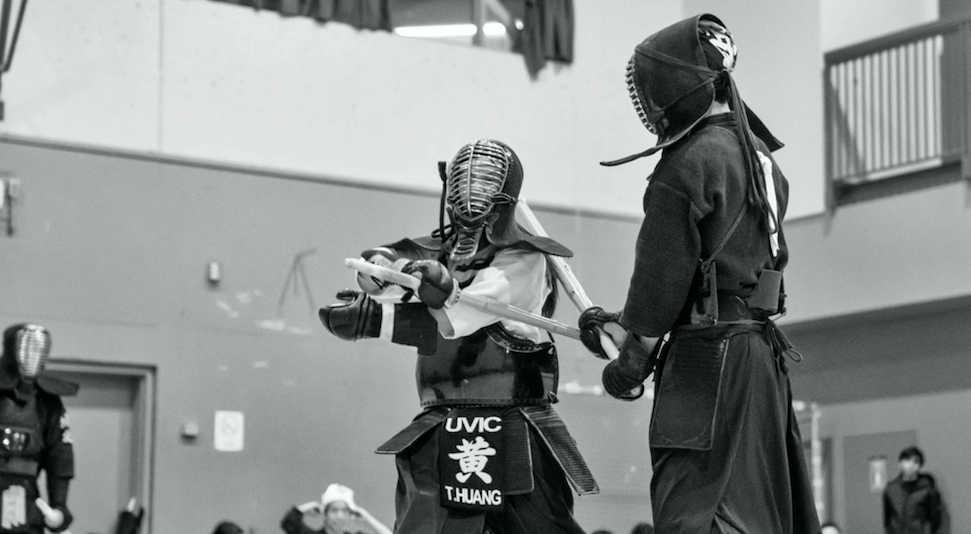One Step, One Strike

The sound of a shinai (bamboo sword) hitting protective headgear is sharp and loud, and it sounds brutal. Yet none of the students flinch — even the children, some as young as six years old. The teacher explains the technique of the strike. The blow bounces off the headgear, leaving no damage to the the person wearing it.
There’s also a certain way of holding the shinai instead of gripping it like a baseball bat.
“One step, one strike,” the sensei says.
A beginner, so new that they don’t have any equipment of their own, practices the technique with a teacher in the corner of Zone 2A in CARSA, carefully repeating the strike over and over again. Two other students jump at each other, screaming the name of their targets: the head, wrist, and the right side of the abdomen.
This is Kendō.
Like many martial arts, Kendō isn’t a just a sport, but an art one must dedicate oneself wholeheartedly to for years to truly become an expert. Rather than something to do for fun in your free time, it is a way of life.
One of the teachers, Sensei Daisuke Hayashi, is a 7th dan, the second highest rank in Kendō. When teaching the students, he moves quickly across the rubber floor, emphasizing the speed necessary in Kendō. It’s important to note that in this sport, the right foot leads at all times in order to “push off” and leap towards your opponent, closing the distance between you and striking before they can dodge or block. It’s best described as a “shuffling” movement. The young students still walk, but have to pause before they strike to correct their footing in order to make an attack.
Everyone, old and new members, push themselves to be just a little better than they were the day before.
Sensei Shigeru Adachi is a 6th dan who trains with the rest of the students during the free practice. Even the newcomers can tell that he is an expert in the way that he moves and attacks. Everyone, old and new members, push themselves to be just a little better than they were the day before.
Tiffany Huang says that this is what made her fall in love with Kendō when she started three and a half years ago.
“I joined it just for fun and then I just fell in love with it… You’re always trying to be better and improve.”
Huang, only 16 years old, is a likely candidate for Team Canada in Kendō and hopes to compete in the next World Kendō Championship in 2021.
“When you’re playing Kendo, you’re really concentrated so you don’t have to worry about anything else,” she says.
The Championship is held every three years, with the one in 2021 taking place in Paris, France. Candidates are chosen based on their performance in smaller tournaments and during normal practices, such as the Steveston Tournament that Huang competed in and won.
“This was my first year in the women’s division and it was all adults and they’re all older than me. At first it was a little intimidating, but it was really fun,” says Huang.
Kendō is a close-knit community, with 5 000 members in Canada and 10 000 in the United States. In order for a club to be founded, a recommendation from another club is needed according to the International Kendō Federation (FIK). In tournaments, other members from the B.C. and Canada Organizations can get together and scope out talent for the national team. While tournaments are not mandatory for grading in Kendō, it does allow for students to hone their skills against unfamiliar opponents.
For Huang, if she wants to be on Team Canada, she will have to compete in an upcoming Tournament in Vancouver in May to show the judges that she is ready.
In higher-ranked fights, there is the idea of imposing one’s will on an opponent, making them react and finding an opening without moving at all.
Kendō, like most martial arts, requires a lot of dedication in order to improve. Great attention is given to the way the uniforms are worn — no wrinkles or loose threads on the edges. Paying attention to these little details fosters a mentality that extends to Kendō itself.
You must be fully aware of the techniques you’re doing in order to pull off a successful attack, as well as what your opponent is doing. In higher-ranked fights, there is the idea of imposing one’s will on an opponent, making them react and finding an opening without moving at all. It’s like faking someone out without even moving.
There’s also the diligence displayed in the students as they continue to show up for practice and constantly sharpen their skills, always pushing themselves to be better. The mentality of Kendō can extend outside of the club and into daily life, too. “It’s for self-growth.” Huang says of non-competitive practitioners.
When asked what made her stick with Kendō, Huang says, “Progress.”
The Victoria Kendō Club meets on Tuesdays and Fridays at 7:00 – 8:30 p.m. in Zone 2A, and Sundays at 3:00 – 5:00 p.m. in Zone 1A, in the CARSA Building. Anyone is welcome to to drop by and see the practice for themselves. An upcoming beginners’ class will be held in May for eight weeks for $50. Registration dates have not been posted at time of writing but will be available on the second week on April.








